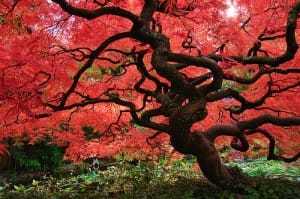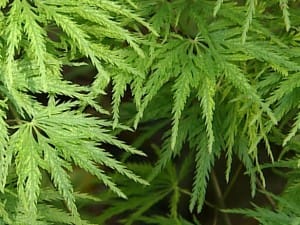Source(s): Stephen D Pettis
One of the loveliest of all the small trees is the group of trees known as Cutleaf Japanese Maples. These oriental relatives of our native maples exhibit traits that have been selected by Japanese gardeners and horticulturists for thousands of years. These are the most refined and most delicate of all the maple family.
The Cutleaf Japanese maple gets its name from its deeply cut leaves. The lobes of the leaves are cut to the leaf petiole. Each lobe is finely serrated and each serration is further toothed. This delicate leaf morphology is colored in shades of either green or red and is the most attractive feature of the plant.
Japanese maples in general are rounded trees with smooth bark and undulating branches. The cutleaf varieties are all very small ranging from 3-9 feet in height. Their small size lends them to being excellent specimen trees near patios, homes and driveways. The tree can be used as an accent and even as a potted plant. Branches of the plant are layered much like many of our native trees such as redbud and dogwood. In deep shade this layering effect is pronounced and the tree takes on the wispy look of smoke drifting. The tree can be trained as either single or multi stemmed tree. Many of the cutleaf varieties will form a multi stemmed shrub-like tree that hides its branches behind a skirt of the wonderful leaves. In this form in makes a rounded mound of vibrant color.
Cutleaf Japanese Maple Requirements
Japanese maples have specific site requirements. These trees prefer dappled shade, although I have seen them in full sun. Japanese maples in the full sun tend to be stressed and pick up summer leaf spot diseases readily. Cutleaf Japanese maples require evenly moist well-drained soil conditions for best performance. These trees should be protected from winds and winter cold by siting them near structures, large trees or among a planting of other small trees and shrubs.
One drawback to Japanese maples in general is their relatively slow growth rate. Japanese maples grow very slowly their first few years after being planted but will pick up speed as the years go by. One can expect a cutleaf maple to achieve maturity in ten to fifteen years depending on growing conditions.
Japanese maples are generally very expensive. This is because propagating maples in general is not an easy task. Japanese maples are more difficult and the cutleaf varieties harder still. The plant is usually readily available but at substantial costs. It is worth it to own one of these gems. Most Japanese maples are grafted. Producers graft the cutleaf varieties onto rootstocks of other maples to improve their performance. You can sometimes see the junction between the upper portion or the scion and the lower portion or the rootstock. Sometimes the rootstock can send up its own trunk or sucker. These occasional suckers should be pruned and removed when they emerge, as they will look completely different than the upper portion of the tree.
When someone asks the best way to grow their own Japanese maples, I tell them to grow them from seed. Collect the seed or samara, a type of winged fruit, prior to their becoming dry. This is generally in June. Plant the seeds directly in moist peat. A relatively small percentage of the seeds should germinate the following spring. Sometimes, Mother Nature will do the work for you. Search under your favorite mature tree for seedlings and transplant them in one-gallon pots filled with general potting soil.
These rounded deciduous trees elicit comment from almost everyone who walks by one in the garden. There is a lovely example just outside the main entrance of the University of Georgia Botanical Gardens. Any time you visit, you will invariably see someone stooping over in front of it to get a look at the sign just beneath it so that they might identify this majestic plant.
Resource(s): Landscape Plants for Georgia
Center Publication Number: 148
- Herbicide Damaged Plants - September 24, 2013
- IPM in the Garden - September 24, 2013
- Leylands Get Really Big - September 24, 2013

